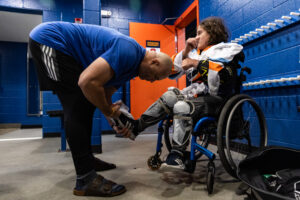Crossing the border for health care
Medical tourism cuts both ways at the U.S.-Canada border
When Austin Zwick and his wife had their first baby, they stayed in the hospital in Toronto for a total of 72 hours. They walked out of the hospital with a crying newborn ‚Äď and no bill.
‚ÄúIt was completely covered by the government,‚ÄĚ said Zwick, who is a public affairs professor at Syracuse University‚Äôs Maxwell School and a dual citizen of the United States and Canada.
Zwick and his wife didn’t have to pay a copay, a premium or any other bill for the birth of their child. By contrast, in the United States, hospital delivery costs vary from state to state. But the average U.S. hospital delivery costs $3,500 per stay, according to the Agency for Healthcare Research and Quality Healthcare Cost and Utilization Project.
But the U.S. system does offer some advantages. Wait times for care have been an issue in the Canadian system, and have been getting worse, according to Cancer Care Ontario.
Zwick is among those who find it frustrating that two countries as close in proximity as the U.S. and Canada are subject to such different health-care systems. But that proximity helps Americans and Canadians alike, especially those who live near the border, seek care outside of their native country. So Canadian patients who need faster care will cross the border to get quality treatment, even for a steeper cost. U.S. patients ‚Äď even some from Syracuse ‚Äď will travel to Canada to save money on a slew of procedures that are cheaper north of the border.
Canadians under the Ontario Health Insurance Plan, or OHIP, can have services reimbursed for care even if they travel outside the country for up to two years under certain conditions, according to the Ontario Ministry for Health Care.
Government reimbursements won’t always cover the costs. OHIP will cover up to about $37 (50 Canadian) a day for outpatient services and about $300 (400 Canadian) a day for inpatient services, according to the ministry’s website. This can still leave thousands of dollars’ worth of bills for Canadian patients without their own private insurance.
Erie County Medical Center in Buffalo, for example, bills patients $3,420 a day before insurance, for care in the intensive care unit. Still, they receive hundreds of Canadian patients a year.
Some parts of Ontario see hospital occupancies of nearly 100 percent, according to a report called Measure Up 2018 published last year. The report said that Ontarians also wait an average of 16 hours in the emergency room, the largest wait time in nearly six years. And certain procedures ‚Äď particularly hip and knee surgeries ‚Äď are less likely to be completed within the province‚Äôs maximum recommended wait time. For those patients, turning to American health care may be their best alternative.
Dr. Samuel Cloud is one of Erie County Medical Center’s most experienced physicians. As the Center’s associate director of the Emergency Medical residency program, the Southern California native has been in the emergency room for over 17 years, treating all kinds of life-threatening injuries. Most of his patients come from Buffalo and the surrounding area in western New York, as Erie County Medical is classified as a level 1 trauma center. But in 2018, Cloud’s team saw one Canadian patient a week on average.
The 52 ER patients were among the 308 Canadians that Erie County Medical doctors treated last year. In 2017, 433 Canadian patients sought care there.
For those traveling to Erie County Medical, the hospital’s reputation and proximity to the border makes it a convenient choice, according to Cloud. Erie County Medical is actually closer to some border towns, such as St. Catharine’s, than the nearest equivalent treatment center in Canada.
Erie County Medical communications vice president Peter Cutler said that while the hospital doesn’t advertise specifically to Canadians, potential patients in Southern Ontario see their TV commercials that are on Buffalo area stations.
As for the kinds of procedures that Canadians are seeking, Cloud said it tends to be surgeries and treatments that may have longer wait times at Canadian hospital for patients willing to pay out of pocket.
‚ÄúThere‚Äôs a waitlist for hip and knee surgeries,‚ÄĚ Cloud said. ‚ÄúCataract surgeries is a big one as well. A lot of our Canadian patients pay for that up front.‚ÄĚ
For hip and knee surgeries, Cloud said that patients go through a process that determines the severity of their need and their prioritization through any insurance they have, which takes a day at most. Then, they are free to schedule their surgery.
Going north for treatment
For many Americans, the cost of paying for a procedure in Canada without insurance is cheaper than paying in the U.S. with insurance. But for others, Canadian health care provides another bonus ‚Äď procedures that aren‚Äôt fully approved by the U.S. government can be performed there.
Robbie Hoover of Buffalo was one of the recipients of those procedures. When Hoover was 16, he was diagnosed with keratoconus ‚Äď an eye condition that causes the cornea to bulge out and can cause the eye to go blind.
When Hoover and his family visited American doctors to find out what his options were, they were told he was only able to do corneal transplants, which would not have permanently stopped the disease. But one eye doctor offered him hope.
‚Äú(My eye doctor) said we could go to Canada to try a treatment there,‚ÄĚ Robbie said. ‚ÄúAll the other ones told me my best option was the transplant.‚ÄĚ
The treatment Hoover got is called corneal collagen cross-linking, which increases the strength of corneal tissue to treat the deformity. The procedure was developed in 1997 in Germany and is commonly used across Europe and Canada. In America, however, the Food and Drug Administration only approved trials in 2008. Cross-linking was approved for American use in July 2016, two years after Hoover had his operation.
‚ÄúNow that it‚Äôs gotten approved over here, we don‚Äôt have to travel as much for stuff like that,‚ÄĚ said Hoover, who works on his family‚Äôs dairy farm. ‚ÄúBut my folks were really kind of surprised at just how cheap it was for something like that, too.‚ÄĚ












